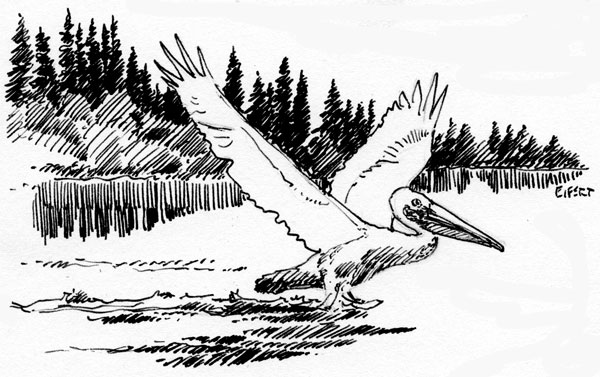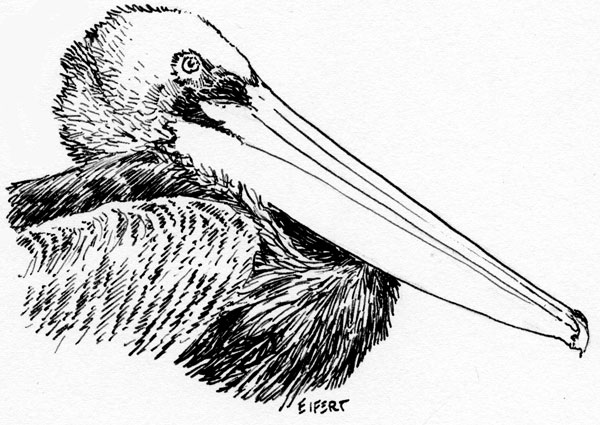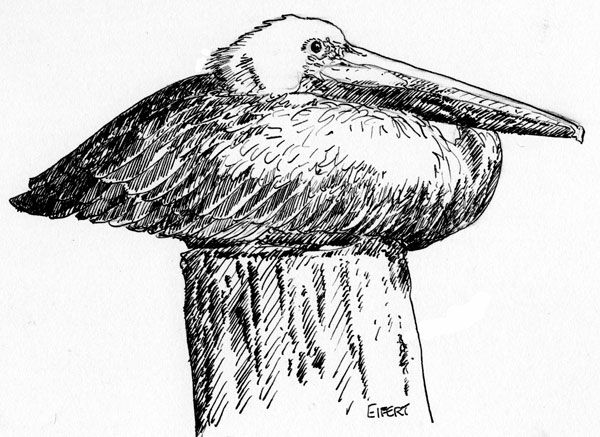| November, 2007
Originally published in 48 North magazine, November 2007 A few months ago I was sailing Sea Witch out of Port Townsend, out towards Point Wilson where there’s often better wind. Suddenly, there is was. Near the Number 2 bell buoy, a large brown bird sat floating, giant outsized beak so large it dipped in the water each time a swell passed by. “Now, THIS is something different” I said aloud to the non-existent crew. As I sailed closer, the crazy bird began running across the water like a DeHaviline Beaver float plane and launched gracefully into the air. Pelican! I had only seen one other brown pelican in Puget Sound, a solitary bird circling with gulls at the Winslow ferry dock a year before. Now, with this second pelican sighting, I’ll keep my eyes open for more. Maybe you can too! Sea Witch at the #2 Buoy, a place of currents and pelicans (on occasion). Brown pelicans: Look for a large, silvery-brown bird sporting a massive bill with a throat pouch. How big? Measured from bill to tail, they’re about four feet long with a wingspan of seven feet! That’s right, seven feet. The bald eagle is actually SMALLER than this bird (they average 31” long with a wingspan of 80” – 4” narrower than the eagle). With a bill and pouch 12” long, no other bird here even comes close to that description. A running takeoff is required to launch such a heavy bird from the water. Eagles, in contrast, can’t easily take off at all if they have a water landing. There are two pelicans in the American West, the white pelican of the interior and the brown that is more at home on salt water. They both share wintering grounds in Southern California. The California brown pelican eats mostly small subsurface schooling fish by diving, mouth open wide, to scoop them up like a living dip net. Remember, eagles don’t dive, but just fly by and grab. Pelicans can dive from 30 feet up, putting up a very theatrical splash upon hitting the water. They don’t actually enter the water with a gaping mouth, but instead time it to open just a millisecond after entry so they don’t break their necks. Nesting colonies, or rookeries, are almost exclusively on small inaccessible coastal islands from Southern California south along the Baja Peninsula. Brown pelicans dive full speed into the water, opening their mouths just at the last moment to net their catch in bucket-sized bill pouches. While safe from coyotes and foxes, these places made the pelican easy prey for egg and feather hunters who would raid rookeries by boat in the 19th and early 20th centuries. Fishermen also slaughtered pelicans because they perceived them to be competitors for valuable fish (which wasn’t true). The threat of DDT and other pesticides also drastically lowered the bird’s reproductive success by interfering with the formation of calcium, producing brittle, thin-shelled eggs. The pelicans gained large doses of these pesticides by ingesting DDT-tainted fish. By 1970, DDT poisoning had resulted in an almost complete reproductive failure of West Coast pelicans. Many thought the brown pelican was history. In 1972, the bird was placed on both our state and the federal endangered species lists, the same year the EPA banned or restricted these pesticides. One year later, a brown pelican recovery plan began and by 1997, 4,000 breeding pairs were counted on WestAnacapa Island in Southern California. The pelican was back, at least in California. Pelican portrait – its dip net bill retracted to normal size. Fully extended, it can hold a bucket of fish. So why are they here? After spring breeding and nesting duties, some birds casually make their way north along the coast, doing a little fishing here, a little resting there…. There are many reported sightings in Washington at La Push and Cape Flattery, and a few along the Straits down to about Port Townsend. Some have even been seen south to Tacoma. They aren’t here yet in large numbers, but with increasing colonies to the south, they will be. Only a few years ago, sailors marveled when they saw a bald eagle. Now, with continued vigilance on pesticides and restoration of native fish habitat, brown pelicans may become our newest wildlife charismatic mega fauna. Pelicans often sit on pilings for a nap, a good way to really see their elaborate feather patterns.
***previous*** — ***next*** |




